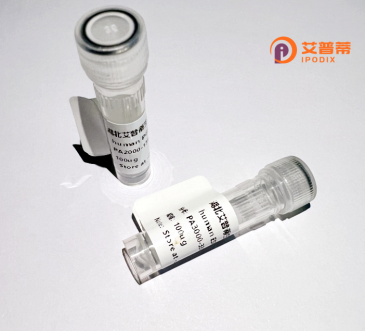
| 纯度 | >90%SDS-PAGE. |
| 种属 | Human |
| 靶点 | PTCD3 |
| Uniprot No | Q96EY7 |
| 内毒素 | < 0.01EU/μg |
| 表达宿主 | E.coli |
| 表达区间 | 38-689 aa |
| 活性数据 | SGS ATLSKVEGTD VTGIEEVVIP KKKTWDKVAV LQALASTVNR DTTAVPYVFQ DDPYLMPASS LESRSFLLAK KSGENVAKFI INSYPKYFQK DIAEPHIPCL MPEYFEPQIK DISEAALKER IELRKVKASV DMFDQLLQAG TTVSLETTNS LLDLLCYYGD QEPSTDYHFQ QTGQSEALEE ENDETSRRKA GHQFGVTWRA KNNAERIFSL MPEKNEHSYC TMIRGMVKHR AYEQALNLYT ELLNNRLHAD VYTFNALIEA TVCAINEKFE EKWSKILELL RHMVAQKVKP NLQTFNTILK CLRRFHVFAR SPALQVLREM KAIGIEPSLA TYHHIIRLFD QPGDPLKRSS FIIYDIMNEL MGKRFSPKDP DDDKFFQSAM SICSSLRDLE LAYQVHGLLK TGDNWKFIGP DQHRNFYYSK FFDLICLMEQ IDVTLKWYED LIPSAYFPHS QTMIHLLQAL DVANRLEVIP KIWKDSKEYG HTFRSDLREE ILMLMARDKH PPELQVAFAD CAADIKSAYE SQPIRQTAQD WPATSLNCIA ILFLRAGRTQ EAWKMLGLFR KHNKIPRSEL LNELMDSAKV SNSPSQAIEV VELASAFSLP ICEGLTQRVM SDFAINQEQK EALSNLTALT SDSDTDSSSD SDSDTSEGK |
| 分子量 | 78.5 kDa |
| 蛋白标签 | His tag N-Terminus |
| 缓冲液 | PBS, pH7.4, containing 0.01% SKL, 1mM DTT, 5% Trehalose and Proclin300. |
| 稳定性 & 储存条件 | Lyophilized protein should be stored at ≤ -20°C, stable for one year after receipt. Reconstituted protein solution can be stored at 2-8°C for 2-7 days. Aliquots of reconstituted samples are stable at ≤ -20°C for 3 months. |
| 复溶 | Always centrifuge tubes before opening.Do not mix by vortex or pipetting. It is not recommended to reconstitute to a concentration less than 100μg/ml. Dissolve the lyophilized protein in distilled water. Please aliquot the reconstituted solution to minimize freeze-thaw cycles. |
以下是3条关于重组人PTCD3蛋白的参考文献及其摘要概括:
---
1. **文献名称**: *Pentatricopeptide repeat protein PTCD3 regulates mitochondrial RNA stability and synthesis*
**作者**: Rackham O, et al.
**摘要**: 本研究揭示了PTCD3在线粒体RNA代谢中的关键作用,通过重组表达人PTCD3蛋白并分析其RNA结合能力,发现其通过与线粒体16S rRNA特异性互作,维持RNA稳定性并影响线粒体翻译功能。
---
2. **文献名称**: *Structural insights into the function of human PTCD3 in mitochondrial ribosome assembly*
**作者**: Brown A, et al.
**摘要**: 利用重组表达和冷冻电镜技术解析PTCD3与线粒体核糖体亚基的复合物结构,阐明PTCD3通过其五肽重复结构域协助核糖体组装,并提出其在遗传性线粒体疾病中的潜在机制。
---
3. **文献名称**: *PTCD3 deficiency impairs mitochondrial energy production and exacerbates cardiac hypertrophy*
**作者**: Chen J, et al.
**摘要**: 通过构建重组PTCD3蛋白并建立条件性敲除小鼠模型,发现PTCD3缺失导致线粒体呼吸链复合物功能障碍,进而加剧心肌肥厚,表明其在心脏能量代谢中的保护性角色。
---
如需更具体的领域(如癌症、结构生物学等),可进一步筛选文献。
**Background of Recombinant Human PTCD3 Protein**
Recombinant human PTCD3 (Pentatricopeptide Repeat-Containing Protein 3) is a mitochondrial protein involved in RNA metabolism and mitochondrial gene expression. PTCD3 belongs to the pentatricopeptide repeat (PPR) family, characterized by tandem repeats of a degenerate 35-amino-acid motif that facilitates sequence-specific RNA interactions. It localizes to the mitochondrial matrix and plays a critical role in post-transcriptional regulation, including RNA stability, processing, and translation, particularly for mitochondrial mRNAs encoding components of the electron transport chain.
PTCD3 is essential for maintaining mitochondrial function and cellular energy homeostasis. Dysregulation of PTCD3 has been linked to mitochondrial disorders, neurodegenerative diseases, and cancer, where impaired mitochondrial RNA metabolism contributes to pathological phenotypes. Recombinant PTCD3 protein, produced via heterologous expression systems (e.g., *E. coli* or mammalian cells), retains its RNA-binding activity and structural integrity, enabling functional studies. It serves as a vital tool for investigating mitochondrial RNA-protein interactions, mechanisms of respiratory chain biogenesis, and the development of therapies targeting mitochondrial dysfunction. Research on PTCD3 also sheds light on the broader role of PPR proteins in organelle gene regulation and evolution.
×